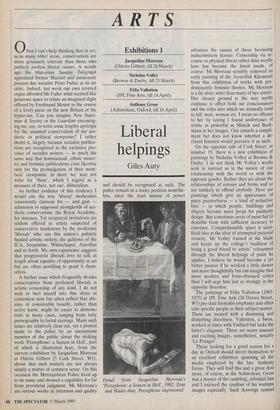ARTS
Exhibitions 1
Jacqueline Morreau (Odette Gilbert, till 26 March) Nicholas Volley (Browse & Darby, till 23 March) Felix Vallotton (JPL Fine Arts, till 14 April) Anthony Gross (Ashmolean, Oxford, till 16 April)
Liberal helpings
Giles Auty
Often I can't help thinking that in art, as in many other areas, conservatives are more genuinely tolerant than those who publicly profess liberal causes. A month ago the blue-rinse Sunday Telegraph appointed former Marxist and passionate present-day socialist Peter Fuller as its art critic. Indeed, last week our own revered organ afforded Mr Fuller what seemed like generous space to refute an imagined slight offered by Ferdinand Mount in the course of a lively piece on the new Britain of the hyper-nat. Can you imagine New States- man & Society or the Guardian encourag- ing me, say, to write some lengthy apologia for the assumed conservatism of my aes- thetic or political viewpoints? I rather doubt it, largely because socialist publica- tions are recognised as the exclusive pro- vince of socialist writers — in much the same way that homosexual, ethnic minor- ity and feminist publications exist likewise only for the promulgation of their mem- bers' viewpoints. In short 'we' may not write for 'them', which I regard as a measure of their, not our, illiberalism.
As further evidence of this tendency I would cite the way 'liberal' modernists consistently clamour for — and gain — admission to supposed strongholds of aes- thetic conservatism: the Royal Academy, for instance. Yet reciprocal invitations are seldom offered to artists suspected of conservative tendencies by the modernist 'liberals' who run this nation's publicly funded artistic outlets: the galleries of the ICA, Serpentine, Whitechapel, Arnolfini and so forth. My own experience suggests that progressivist liberals love to talk at length about equality of opportunity in art but are often unwilling to grant it them- selves.
A further issue which frequently divides conservatives from professed liberals is artistic censorship of any kind. I do not wish to hurl myself into this abyss of contention now but often reflect that abs- ence of conceivable benefit, rather than active harni, , might be easier to demons- trate in many cases, ranging from tatty pornography to foetal earrings. Many such issues are relatively clear-cut, yet a protest made to the police by an anonymous member of the public about the striking work 'Persephone: a Season in Hell', part of which is illustrated here, from the current exhibition by Jacqueline Morreau at Odette Gilbert (5 Cork Street, W1), shows that such matters are not always simply a matter of common sense. On this occasion the Metropolitan Police lived up to its name and showed a capability for far from provincial judgment. Ms Morreau's are serious works in intention and quality and should be recognised as such. The police remain in a tricky position nonethe- less, since the least misuse of power Detail from Jacqueline Morreau 'S 'Persephone: a Season in Hell', 1982: Zeus and Hades dine, Persephone imprisoned advances the causes of those favouring indiscriminate licence. Censorship via re- course to physical threat rather than woolly laws has become the latest mode,. of course: Ms Morreau sensibly removed an early painting of the Ayatollah Khomeini from this exhibition of works with pre- dominantly feminist themes. Ms Morreau is a far abler artist than many of her sisters. Her chosen ground is the way myths continue to affect both our consciousness and the roles into which we naturally tend to fall: man, woman etc. I mean no offence to her by saying I found undertones of artists as powerful as Munch and Beck- mann in her images. One intends a compli- ment but does not know whether a de- clared feminist would perceive it as such.
On the opposite side of Cork Street, at number 19, there is a new exhibition of paintings by Nicholas Volley at Browse & Darby. I do not think Mr Volley's works seek to instruct us in the nature of our relationship with the world or with the opposite gender. Rather they are about the relationships of colours and forms and so are unlikely to offend anybody. Here are paintings which give an appearance of gutsy painterliness — a kind of seductive brio — in which people, buildings and objects become mere props for painterly design. But sometimes areas of paint fail to describe form with sufficient. accuracy to convince. Comprehensible space is sacri- ficed also at the altar of attempted pictorial vivacity. Mr Volley trained at the Slade and keeps up the college's tradition of being a good friend to artists' colourmen through the liberal helpings of paint he applies. I believe he would become a yet better painter if he worked a little slower and more thoughtfully but can imagine that more modern and form-obsessed critics than I will urge him just as strongly in the opposite direction.
The paintings of Felix Vallotton (1865- 1925) at JPL Fine Arts (26 Davies Street, W1) pre-date formalist emphases and often take specific people as their subject matter. These are treated with a disarming and disturbing directness. Vallotton, a Swiss, worked at times with Vuillard but lacks the latter's elegance. There are many unusual and exciting images, nonetheless, notably 'Le Potager'.
Those looking for a good reason for a day in Oxford should direct themselves to an excellent exhibition spanning all the media employed by the late Anthony Gross. They will find this and a great deal more, of course, at the Ashmolean. Gross was a master of the rambling, informal line and I enjoyed the candour of his wartime images especially. Such drawings remind
us that it was men and women, rather than just formal shapes, who served this country in the last world war.



























































 Previous page
Previous page